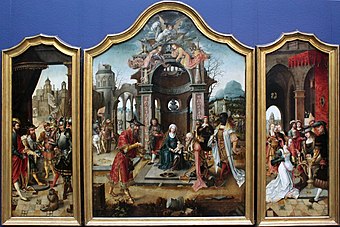
Antwerp Mannerism is the name given to the style of a group of largely anonymous painters active in the Southern Netherlands and principally in Antwerp in roughly the first three decades of the 16th century, a movement marking the tail end of Early Netherlandish painting, and an early phase within Dutch and Flemish Renaissance painting. The style bore no relation to Italian Mannerism, which it mostly predates by a few years, but the name suggests that it was a reaction to the "classic" style of the earlier Flemish painters, just as the Italian Mannerists were reacting to, or trying to go beyond, the classicism of High Renaissance art.

Max Jakob Friedländer was a German-Jewish museum curator and art historian. He was a specialist in Early Netherlandish painting and the Northern Renaissance, who volunteered at the Kupferstichkabinett Berlin in 1891 under Friedrich Lippmann. On Lippmann's recommendation, Wilhelm von Bode took him on as his assistant in 1896 for the paintings division. He was appointed deputy director of the Kaiser Friedrich Museum under Bode in 1904 and became director himself from 1924 to 1932, working on his history From Van Eyck to Bruegel and the 14-volume survey Early Netherlandish Painting. In 1933 he was dismissed as a "non-Aryan" and in 1939 had to move to Amsterdam because he was Jewish. He attained the rank and title of geheimrat under the German Empire. He also donated several works to the collection and worked in the art trade as an advisor, to Hermann Göring among others.

Joos van Cleve was a leading painter active in Antwerp from his arrival there around 1511 until his death in 1540 or 1541. Within Dutch and Flemish Renaissance painting, he combines the traditional techniques of Early Netherlandish painting with influences of more contemporary Renaissance painting styles.
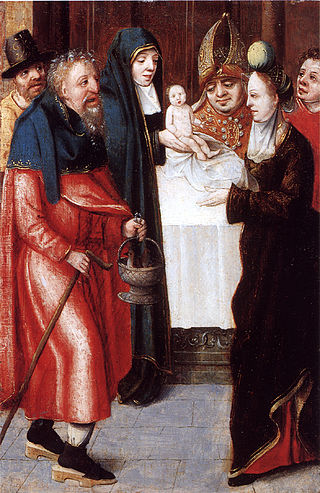
The Master of 1518 is a Flemish painter belonging to the stylistic school of Antwerp Mannerism. A group of unsigned paintings is attributed to this artist on stylistic grounds, and his name is derived from the date inscribed on the painted wings of a carved wooden altarpiece of the Life of the Virgin in St. Mary's Church in Lübeck Germany. Although this artist’s identity is not known with certainty, some scholars believe that the Master of 1518 was either Jan Mertens the Younger or Jan van Dornicke, or that all three were the same person. His paintings are primarily crowded depictions of religious scenes combining Gothic and Renaissance styles. He frequently incorporated elaborate clothing and architectural ruins.
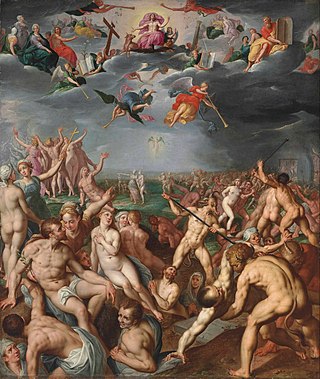
Jacob de Backer was a Flemish Mannerist painter and draughtsman active in Antwerp between about 1571 and 1585. Even though he died young at the age of 30, the artist was very prolific and an extensive body of work has been attributed to him. Art historians are not agreed on how many of these works are autograph or the product of a workshop. The works attributed to the artist or his workshop are executed in a late-Mannerist style clearly influenced by Italian models.

Herri met de Bles, also known as Henri Blès, Herri de Dinant, Herry de Patinir, and il Civetta, was a Flemish Northern Renaissance and Mannerist landscape painter, native of Bouvignes or Dinant.

Jan Wellens de Cock or Jan de Cock was a Flemish painter, woodblock artist and draftsman of the Northern Renaissance active in Antwerp. Recent discoveries and a re-evaluation of the links between the works attributed to Wellens de Cock and those of contemporaneous artists of Leiden have caused a large portion and potentially all of the works formerly attributed to him to be re-attributed to one or more anonymous artists active in Antwerp or Leiden referred to by the notname Pseudo Jan Wellens de Cock or Master J. Kock or some other anonymous artists believed to have worked in Leiden in the studio or immediate circle of Cornelis Engebrechtsz.

Jan de Beer, formerly known as the Master of the Milan Adoration was a Flemish painter, draughtsman and glass designer active in Antwerp at the beginning of the 16th century. He is considered one of the most important members of the loose group of painters active in and around Antwerp in the early 16th century referred to as the Antwerp Mannerists. Highly respected in his time, he operated a large workshop with an important output of religious compositions.

The Master of the Legend of the Magdalen was an Early Netherlandish painter, active from about 1483 to around 1527. He has not been identified; his name of convenience is derived from a large, now-dispersed altarpiece with scenes from the life of Mary Magdalene, which has been dated to between 1515 and 1520 based on the costumes of the donor portraits. However other works attributed to him are extremely difficult to date with any accuracy. Many paintings have been linked with the triptych, which is thought to have been finished late in the artist's career. Other major works include his two Magdalen panels in London.

Northern Mannerism is the form of Mannerism found in the visual arts north of the Alps in the 16th and early 17th centuries. Styles largely derived from Italian Mannerism were found in the Netherlands and elsewhere from around the mid-century, especially Mannerist ornament in architecture; this article concentrates on those times and places where Northern Mannerism generated its most original and distinctive work.
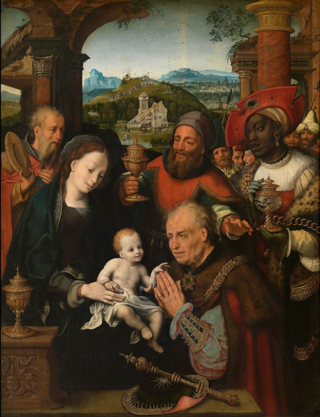
Cornelis van Cleve, Cornelis van Cleef or Cornelis van der Beke, nickname Sotte Cleve was a Flemish Renaissance painter active in Antwerp who is known for his religious compositions and portraits. Starting his career in Antwerp in the workshop of his father Joos van Cleve, he later worked for a while in London. When he failed to achieve success in England, he became insane and stopped painting.

The world landscape, a translation of the German Weltlandschaft, is a type of composition in Western painting showing an imaginary panoramic landscape seen from an elevated viewpoint that includes mountains and lowlands, water, and buildings. The subject of each painting is usually a Biblical or historical narrative, but the figures comprising this narrative element are dwarfed by their surroundings.
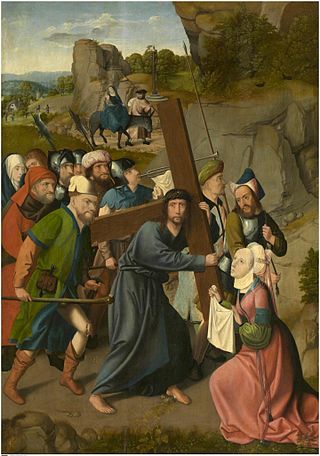
The Master of Hoogstraeten is the Notname given to a Flemish painter or a collective of painters active in Antwerp in the early 16th century. The master created principally religious paintings and is considered a member of the Antwerp Mannerists.

The Master of the Antwerp Adoration was a Flemish painter in the style of Antwerp Mannerism, whose compositions are typically filled with agitated figures in exotic, extravagant clothes. His notname is from a triptych showing the Adoration of the Magi, acquired by the Antwerp Museum of Fine Arts.

The Master of the Prodigal Son, was the notname given to a Flemish painter and designer of tapestries and stained glass. He was active in Antwerp where he operated a large workshop between 1530 and 1560. He painted religious subjects, landscapes, genre scenes and allegories. He is regarded as a leading master of Flemish Mannerism in the sixteenth century.
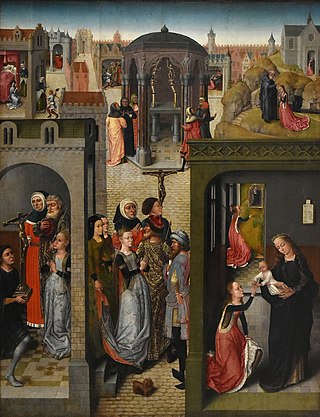
The Master of the Legend of Saint Catherine is the notname for an unknown late 15th century Early Netherlandish painter. He was named after a painting with Scenes from the Legend of Saint Catherine, now kept in the Royal Museums of Fine Arts of Belgium. He was active between c. 1470 and c. 1500, probably around Brussels.

The Master of the Lille Adoration, was an Early Netherlandish painter active in Antwerp, as one of the Antwerp Mannerists. He was first suggested as a distinct but unknown figure in 1995 in an article by Ellen Konowitz, a proposal which has been widely accepted. In 2014, Christie's gave his dates as "active Antwerp by c. 1523/35".

The Master with the Parrot or Master of the Parrot is the notname given to a group of Flemish painters who likely worked in a workshop in Antwerp in the first half of the 16th century. They produced devotional pictures for the local bourgeoisie in a style reminiscent of contemporary Flemish painters working in an Italianate style.
Early Netherlandish Painting is a pioneering 14-volume series of illustrated books by the German art historian Max Jakob Friedländer (1867–1958). The first volume was published in 1924, and the series ran until 1937. It was the first comprehensive modern art-historical survey of Early Netherlandish painting, a term often used in art history to describe artists of the Low Countries during the 15th- and 16th-century Northern Renaissance.

Adriaen van Overbeke, Adrian van Overbeck and Adriaen van Overbeke was a Flemish Renaissance painter in the style of Antwerp Mannerism. He operated a large workshop with an important output of altarpieces, which were mainly exported to Northern France, the Rhineland and Westphalia. His known works were predominantly polychromed wooden altarpieces with painted shutters, which were created through a collaboration between painters and sculptors.
